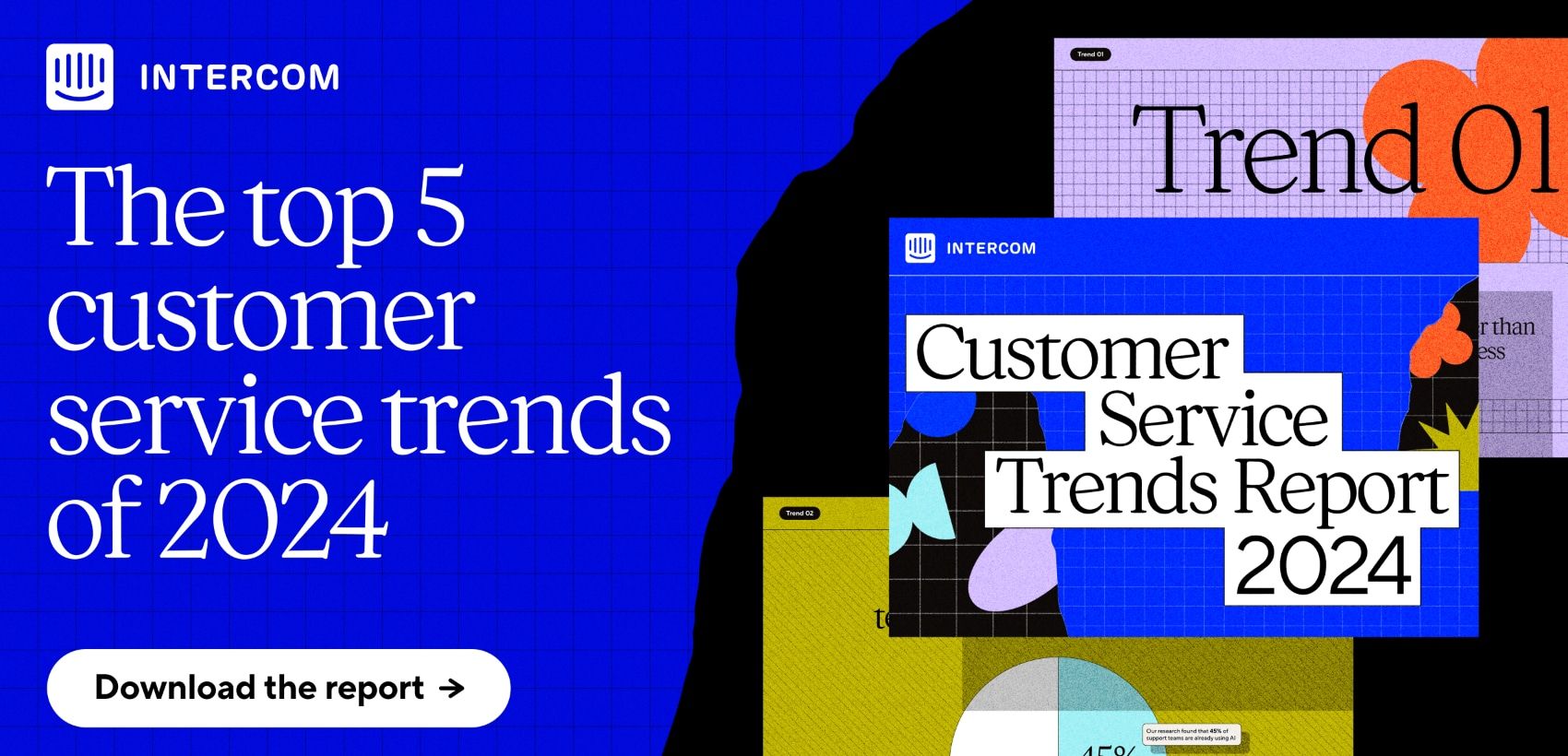
This time, it’s personal: Redefining automated support in the modern age
Main illustration: Sofie Levin
Many support leaders worry that by automating their support they’ll make it less personal.
But automated support can (and should) be deeply personal. In today’s modern age, support teams simply need to redefine what being “personal” means.
At Intercom, our mission has always been to make Internet business personal. In the early days we used to think that personal support was solely reserved for a human – a friendly chat, a few choice GIFs, and the exchange of first-hand information. But with the development of automation, like bots and contextual help content, we’ve significantly changed our perception of what being personal means.
In a modern world where customers are perennially busy, the most personal thing you can do is respect their time. When implemented right, bots and automation help you to be more empathetic – one of the most important support trends for 2022 – as well as anticipate your customers’ needs, quickly route complex queries to the right people and teams, and instantly resolve simple queries.
If your team is pondering whether to use “bots versus humans?” that’s actually the wrong question. Bots and humans complement each other, they each excel at different tasks. The right question then is “How can we be personal in the right context to meet the needs of modern customers?”
At Intercom we’ve experienced many benefits from embracing the power and personal touch of bots – and so have our customers. From happier customers to improved efficiency to a more productive team, here’s how you can use automated support to achieve great, personal results at scale.
Automated support can (and should be) deeply personal
When you think of automated support being personal, you may be imagining a chatbot introducing itself as a lovely and capable assistant, called Rebecca or Nathan. But personal automation has nothing to do with naming a bot or making a bot say nice things.
It has everything to do with understanding your customers’ context and creating bots that accurately anticipate and address their needs in specific situations. Here’s how automated support – when done right – can be deeply personal.
Fast, accurate resolutions are what customers want
As humans, the most precious and fleeting commodity we have is time. Setting up personal automation means you’re respecting your customers’ time by getting them an answer as fast and as accurately as possible. That’s true empathy.
“When a customer has a simple question, what they want is a fast, accurate answer – now”
Think about it: no one likes waiting on the phone line for 45 minutes or repeating the issue they’re experiencing for the third time to the third person. When a customer has a simple question, what they want is a fast, accurate answer – now.
This is where chatbots excel at being personal. They resolve simple frequent queries like “How do I change my credit card details?” and “What are your US shipping times?” accurately and instantly.
Oh to be understood: Contextual support is personal support
One of our most fundamental needs as humans is to feel understood and known. In this digital era, one of the most personal things you can do is gather contextual data about your customers and serve up relevant answers and help content based on their needs.
“79% of customers are willing to share relevant information about themselves in exchange for contextualized interactions”
A recent study by Salesforce revealed that 79% of customers are willing to share relevant information about themselves in exchange for contextualized interactions in which they’re immediately known and understood.
This is another area where chatbots excel at being personal. You can set up a bot to capture custom data about your customers – like what plan they’re on, the type of query they have, and how urgent their issue is – then route their query to the right team based on what they need.
Bots and humans are good at different things: Assign them queries and tasks accordingly
Both humans and bots can be personal in the right context and for the right customers and situations. They each excel at handling different types of questions and tasks in a personal way. To really illustrate this point, let’s take a look at two different scenarios:
- Scenario #1: A customer has a simple question. They can choose between a friendly human in an hour and a quick and accurate chatbot in less than a minute. What will they choose? Of course, they’ll choose the chatbot every time.
- Scenario #2: A customer has a sensitive, complex query related to their billing. They can choose between a friendly human in an hour or a quick chatbot. What will they choose? In this case, they’ll likely require the deep expertise, privacy, and emotional sensitivity of your support team.
Want a quick cheat sheet? Here’s a breakdown to help you decide which approach is best for which queries.
Where bots win:
- Answering common questions quickly
- Reducing hold times
- Quick routing to the right place
Where humans win:
- Answering a variety of questions
- Dealing with complex situations
- Understanding human emotion
3 strategies for making automated support personal
If you’re concerned that introducing automation into your support strategy will feel impersonal to your customers, remember that the tools that you have available to you now aren’t at all like your old impersonal legacy support tools. Here are a few ways you can put automation to work for you, while still keeping it personal.
1. Automate the transactional
Setting up automation to handle the transactional side of things really respects your customers’ time. For example, you can set up an FAQ bot to automatically answer simple questions like, “How can I change my profile picture?” or “How do I update my billing details?” that don’t need to involve a human. Some bots – like Intercom’s Resolution Bot – can answer your customers’ questions before they even finish typing.
You can also set up a bot to set customer expectations for how long it’ll take to get a response, or to collect personal information that will speed things up, like the customer’s email address or order number. And then, at the end of the day, when the conversation is closed, you can use automation to send a survey to see how your team did. This helps you identify opportunities where you can improve your automation and make it more personal.
2. Personalize your customers’ path with contextual routing
The other area where we heavily apply automation is customer routing. For conversations not addressed by a bot, our assignment rules take care of routing nearly half of conversations to the right place, with the rest routed to an escalation inbox to be examined by a human.
What this “right place” looks like varies, so our assignment rules consider the customer’s history with us (if there is one) and decide where they should go to get the help they need. This is how we keep routing personal: we take into account multiple factors – not just account spend – to determine where our customer should go. These factors include:
- Message keywords
- Products in use
- Company type
- Page URL
- Customer tenure
For instance, if someone starts a conversation from our Developer Hub or their message contains technical words like “python” that clearly indicate a technical topic, we know they will likely benefit most from talking to our Customer Support Engineers (CSEs). Not only does this save our team time by automating the number of manual escalations up to technical CSEs, but it inherently respects the customer’s time, removing an unnecessary touch from a non-technical resource and getting the customer’s query in front of the person that is best equipped to handle it, shortening resolution time.
3. Measure the impact and optimize your approach
Finally, you’ll want to measure how your automation is doing – in particular how it’s improving your customers’ experience and enhancing your team’s efficiency. By using automation, you’ll already have a head start – last year, we learned that companies that use chatbot technology for support are 30% more likely to report an increase in customer satisfaction and 60% more likely to report an increase in resolution times.
You should also look out for opportunities to improve the customer experience. If there’s an answer or message that’s underperforming, try tweaking the copy or filters or training the bot further to improve performance.
When automated support isn’t the right solution
Of course, there are some cases where automation isn’t useful. This is usually when you’re in a situation where you can’t personalize the kind of support you’re offering. Here are three types of conversations you should reserve for your human team – although even then you can use automation to route conversations to the right people and teams.
1. Customers with sensitive issues
Requests for upgrades or cancellations should be answered by a human. When a customer is trying to give you money, you can’t allow a chatbot to jeopardize the relationship before it even begins. If they’re thinking about canceling, poor automation might make any negative feelings even worse, or ruin any chance at saving the relationship.
2. High-touch customers
Customers with lots of questions, and those who need hand-holding through difficult processes or explanations, benefit from working with a human. Most of the time, these folks are more than willing to wait for a person to talk to if they know they’ll get the help they need.
3. New customers or trial customers
Your newest converts might end your relationship early if they find themselves continually blocked by chatbots, no matter how “helpful.”
Automated customer support will enhance your team – never replace them
Automation empowers you to scale your support and provide customers with the answers they need, when they need them. But it’s only one piece of the puzzle for delivering fast, personal support to your customers at the scale your business needs.
On its own, automation won’t solve all of your customers’ problems – it needs to be supported by a strong knowledge base and, of course, the knowledge and empathy from your talented support team. Without these resources and humans backing it up, your bots will do little more than annoy customers who are desperately trying to seek solutions to their problems.
Furthermore, automation can never replace the empathetic human touch and technical expertise of your support team. Instead, use it to enhance your team’s capabilities and win them back more time so they can focus more on the challenging work they love.








